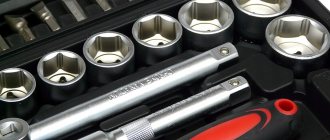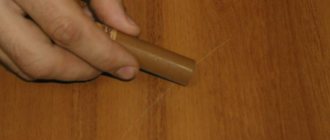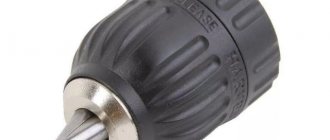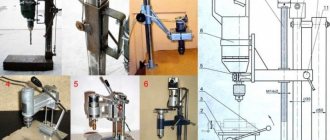Today, stainless steel rivets are widely used to connect metal sheets together. To install them, a special tool is used, which is simple, convenient and functional. However, in the process of repair and finishing work, it may be necessary to dismantle hardware. Currently, there is no specialized tool for removing fasteners. Therefore, ordinary people have a logical question: how to remove metal rivets and what tools can help with this?
How to remove a rivet from a metal structure
A rivet is a disposable fastener designed to fasten 2 or more parts.
To install this fastener, a riveter is used. How to remove a rivet will have to be based on the availability of available tools, because there is no universal tool. In addition, the selection of metal construction materials is carried out in accordance with the technical characteristics. Aluminum, copper, and steel vary in hardness; they are susceptible to diffusion, oxidation rates, and other physical and chemical processes to varying degrees. The only method that can be called almost universal is drilling. This process can be carried out in 3 ways, which in most cases depends on how close the fastening metal is to the elements being fastened.
- The tight fit of the fastening rod to the hole means that it will not be possible to knock it out. In this case, dismantling will have to be carried out by completely destroying the rod. It is necessary to accurately determine the diameter of the drill used to make a hole in the metal structure. The same drill diameter will be required to remove, or rather, drill out the rivet along with the rim. It is better to start work on removing the rivet at low speeds so that the drill does not damage the fastened parts. However, this method is not the most reliable for dismantling a structure that will need to be reassembled.
There is always a risk that the drill bit of a hand tool will move to the side, enlarging the hole. In this case, it will be difficult to re-fasten the parts using the old marks.
- Dismantling of aluminum rivets can be done using the corkscrew principle with a drill of a smaller diameter than the rivet itself, a self-tapping screw, a screwdriver and pliers. Despite the large list of tools, the operation will require less time. A hole is drilled in the middle of the rivet, a self-tapping screw is screwed in, and the resulting part is removed with pliers. Steel that fits tightly is almost impossible to remove in this way due to the fact that the drill gets very hot.
- Steel ones can be removed using a combined method. To begin with, it is drilled out from both sides along the rim so that the ring-clamps are separated from the rivet rod. Then, in accordance with popular wisdom, they knock out the wedge with the wedge. To do this, you will need a screwdriver with a handle that cannot be destroyed with a hammer blow. It is inserted into the middle of the rod and with gentle blows of a hammer on the end of the handle, force is applied to remove the rod from the hole; this is the only way it can be removed without damaging the metal being fastened. If the rivet was fastening a thick structure, but it comes out hard, then, if the end is large enough to be grasped with pliers, it can be pulled out. A rivet that does not yield easily can be turned, but it is not recommended to pull it out by shaking if the hole is necessary to re-fasten the structure.
What is the algorithm for replacing a cylinder lock?
Many owners are interested in repairing locks with a cylinder mechanism. To repair a cylindrical entrance lock, follow the step-by-step algorithm.
Required Tools
Which replacement lock should I choose?
The selection of a lock for the front door in an apartment or house is made according to the parameters of the broken lock. Select a model with a similar width, length, body depth and backset. The length should not stick out or fall out of the sash to reduce the likelihood of burglary.
Models with a turntable are more convenient due to the ability to lock the house from the inside without keys. It is also important that the bar of the new handle is not reduced in comparison with the previous one, so that empty spaces and traces of use are not visible.
Removing the old lock and installing a new one
Masters are interested in how to change a lock and where to start? First, it is necessary to replace the lock cylinder of the front door. To do this, remove the old larva. You need to unscrew and pull out the fastening screw, which is located on the end of the punk. To get the larva, take its inner side, pull it towards you and carefully unfold it. The larva will be received when the mechanism is in the required place.
If your door can only be opened from both sides with keys, then you need to insert them into the hole, turn them a little by 15℃ and tilt them towards you. Then unscrew the fastening screws from the handles and remove the fittings. After this, unscrew the screws from the end and remove the mechanism.
Now we begin to install new locks on the iron door. You need to start by installing the housing. It is important that the fastening is in the same holes where the mounting bolts were. If they do not match even by 2mm, then you need to drill new ones. Then the lock is secured with rivets and the cylinder is installed.
After this, a square for the handle is installed, holes are drilled for tight installation of the screed, and the handles are installed. The standard screed size is 6 cm. up to 7cm. They are trimmed if they are very long. After this, the handles are pulled together on both sides and secured with screws.
But changing the lock on the door leaf is not all; now you need to check the functionality of the handle. Afterwards, the operation of the lock is checked in the open and closed positions of the valves. If the keys do not turn in the closed position, the bolt does not fit into the hole. To determine the degree of undercut, you will need to lubricate the tongue with liquid soap. Where there is a wet mark left, a cut is made with a grinder.
How to remove a blind rivet
The pop rivet is somewhat easier to remove. When dismantling it, it is necessary to remove the ring formed during fastening. If possible, when compressing the material of the structure, insert a metal saw blade, the fastening can be cut off, and the pin can be removed by pulling it out by the rod. If sawing or cutting is not possible, there is always a chance to remove the fastening using the first method - drilling.
The hidden fastening can only be removed by drilling, and the exhaust heads can be knocked off with a hammer if the strength of the material they fasten is greater than that of the fastening itself. Provided that using this method of dismantling, there is no confidence in 100% safety for your own hands and the appearance of the material, it is better to abandon it.
If you find an error, please select a piece of text and press Ctrl+Enter.
Procedure
Cylinder mechanism
As already noted, there is no need to remove this lock from the door. Only a few simple manipulations are performed:
Level mechanism
Here we are no longer talking about partial repair of the constipation, but about its complete replacement. Although there are options. If the product is imported, then it is quite possible to change the core with recoding of the levers (internal pins that ensure the level of secrecy). Some manufacturers supply the market with spare parts with a set of keys “for them”.
The algorithm of actions is the same, but there are some differences:
Crossbar mechanisms
In this case, knowledge of how to change the lock on a metal door of a simpler design is clearly not enough. Depending on the model, there are several stops, and they can come out of the canvas in different places - both on the side, at the bottom, at the top. It is their presence that significantly complicates the work; if possible, it is better to remove the sash.
Further, everything is similar to the procedure for dismantling/installing a lever or cylinder mechanism.
Replacing a lock on a metal entrance door is not particularly difficult if you are careful and careful. The latter requires compliance with a number of rules:
Such forethought will allow you to install a new (or repaired) lock quickly and efficiently.
Source
Three ways to remove a rivet
Many industrial products use rivets as a way to securely and quickly fasten an assembly that will not be disassembled in the future. Thin sheet metals are often joined this way. If you have a need to remove the rivet without damaging the surface of the product, then I will offer three accessible methods to achieve the desired result.
Drilling out a rivet
The simplest and safest way, from a mechanical point of view, is drilling with a drill.
Take a screwdriver or drill. Install a drill of the required diameter. And we drill through the rivet.
This method will not damage the metals being joined if the drill is selected correctly. Although it is quite specific and will not suit you if your rivets have a semi-circular head.
Cutting with a grinder
This is the fastest and at the same time the most traumatic way to remove rivets. Therefore, if you are not confident in using a tool such as an angle grinder (grinder), I sincerely do not recommend using it.
Using an angle grinder, we cut off the heads from all installed rivets.
And use a screwdriver to knock them out.
That's the whole trick.
This method simply damages the surface of the product and breaks the disk itself, since the cutting occurs at an angle. And one wrong move can ruin everything. Be sure to use protective equipment.
Replacing the lever mechanism of the lock
Changing a lock on a lever-type iron door is more difficult than changing a cylindrical one. But it can be done at home. A lever lock in a metal door more reliably protects the house from burglary.
What tools are needed?
How to choose a new lock?
The selection of a deadbolt lock for an iron door is carried out according to the parameters of the previous one. The length and width of the mechanism are taken into account.
We remove the old structure and install a new one
To dismantle, you need to unscrew the fastening screws at the end of the mechanism. The device is held only by them, so you will need to pull it out. Then the decorative trims are removed.
We are starting to install a new lock for a metal door. In order to install the lock cylinder, you will need to drill out the hole a little if it is too small. The subsequent insertion of the lock must coincide exactly with the holes for easy insertion of the key.
The replacement of locks in iron doors of the lever type is secured with rivets. Now you need to install the decorative trim, and the center must coincide with the hole so that the keys can be inserted and removed without difficulty.
The next stage is to check the functionality of the handles and mechanism of the metal entrance door. If the bolts do not align when closing, then smear them with liquid soap and try to close the door. Wet areas are drilled out to allow free movement of the tongues.
Cut off the rivet head with a chisel or screwdriver
Now the method is what is called classic. It is used by the majority of both professionals and beginners. It does not require special equipment, electricity, or training. The most affordable and at the same time the slowest way to cut rivets. You will need:
If the size is small, take a screwdriver, place it at an angle and cut off the cap with a hammer.
Next we knock it out with the same screwdriver.
If the rivet is large, then it is better to use a chisel. We use it in the same way as a screwdriver.
We also knock it out with a screwdriver.
This method can be used when there are few rivets: one, two or three. Or when there is none of the above equipment in the first two methods. If there are a lot of rivet joints, it is certainly better to use a more mechanized removal method. Be careful when working with metals. Also share your suggestions in the comments, everyone will be interested.
Watch the video
Power supply for a beginner radio amateur
Next post
A quick way to install poles
Comments
Site headings
- Aviation
- Auto and motorcycle
- Army and Navy
- Archeology
- Animals
- Health
- Celebrities
- Games
- Interesting
- Internet and computers
- Story
- Space
- Crime
- Cooking
- Culture and art
- Fashion & Style
- Music
- Science and technology
- News
- Society
- Hunting and fishing
- Policy
- Nature
- Psychology
- Travel and leisure
- Entertainment
- Religion
- Rodnoverie
- Needlework
- Garden
- Homemade products
- Sport
- Construction and design
- Secrets and myths
- Economy
- Humor, jokes
- Sandbox
latest comments
When I play Topigr, I would like us to be completely free of problems, and not bess.
Now there is so much that is inexplicable in the world that mom, don’t worry.
Pindos, admit that you have not been to the moon and we will leave you behind.
Basque is the same banderlog as Rotaru! Basques, why aren’t you going to perform in Crimea and Donbass?
The so-called “truly great star” sponsored the genocide of Donbass! Let him speak.
Another pig returned to his pigsty. Donbass has become cleaner.
I agree 90% with the author’s opinion. Here is the opinion of a.filipovic. I still don’t understand who it is.
This is not a sandstorm. The sea receded with the wind and the wind raised the sand.
Gaining popularity
How to make a good wooden chair with your own hands
How to fix a garland if one color doesn't light up
Manual sewing machine from unnecessary trash
How to make a heated bath in your summer cottage
DIY chaise lounge chair made from planks
The information and entertainment site “Labuda” is daily, operational, relevant, interesting news and useful information from different spheres of life.
Full or partial copying of labuda.blog site materials is permitted only if an active and indexable hyperlink to the publication source is indicated.
legal information
Dear authors, remember that the publications you post must not violate the laws of the Russian Federation and the copyrights of third-party resources.
* Extremist and terrorist organizations banned in the Russian Federation and the Republics of Novorossiya: “Right Sector”, “Ukrainian Insurgent Army” (UPA), “ISIS”, “Jabhat Fatah al-Sham” (formerly “Jabhat al-Nusra”, “Jabhat al-Nusra"), National Bolshevik Party (NBP), Al-Qaeda, UNA-UNSO, Taliban, Majlis of the Crimean Tatar People, Jehovah's Witnesses, Misanthropic Division, Brotherhood "Korchinsky, "Art preparation", "Trident named after. Stepan Bandera", "NSO", "Slavic Union", "Format-18", "Hizb ut-Tahrir".
Removing rivets without drilling
Blind rivets, or POP rivets as they are also called, are a popular fastener for joining sheets of metal. The installation of these hardware is carried out with a special device, which allows you to quickly and reliably fix them in a pre-prepared through hole. Unfortunately, there is no device that removes rivets of this type, and if it is necessary to separate sheets connected by rivets, they most often resort to drilling them out with a drill. This simple and effective method requires care and precision, and besides this, success can only be achieved with the right choice of tool. The drill should not completely drill out the rivet and push it out of the hole - its task is to destroy the side that holds the body of the hardware in the design position.
Replacing a lock on a metal entrance door: procedure and recommendations
Situations where keys are lost, the mechanism does not work correctly, and the like occur quite often. Therefore, many are faced with the need to replace the lock on a metal front door. Knowing the design features of the locking device and the specifics of its installation, you can do everything yourself without wasting time looking for a professional.
Removing the rivet using improvised tools
As we have already said, the basis for dismantling any POP rivet is to machine the hollow section of its head until it comes off the shank. This simple but very precise operation can be performed using a thin chisel or flathead screwdriver, as well as a hammer. The sequence of performing this work is as follows:
- First of all, it is necessary to determine the thickness and material properties of the sheets connected by blind rivets. Knowing the parameters of the metal, you can accurately select tools and approximately calculate the maximum permissible force during dismantling. When working with very thin sheet material, our method can hardly be called optimal and can only be used at your own peril and risk.
To remove the rivet, place a chisel or the tip of a screwdriver between the side of its head and the sheet and, gently tapping it with a hammer, bend it. The thinner the material connected with fasteners, the more delicately you need to treat the work. You should also carefully consider the choice of tool - it should be thin enough so that it can be carefully driven under the side.- If the removal of the fixing part of the hardware was successful, you need to carefully remove the fastener from the through hole. For this purpose, it is best to use a thin screwdriver or a thin metal rod of suitable diameter. Your task in this case is simply to push the tail of the rivet out of the hole. Most often, this is possible without much effort, but sometimes you may need a hammer again - one or two blows on a screwdriver or rod aimed at the leg of the rivet will help push it out of its “home” place.
This method is good because it can be used even where connecting electrical tools is impossible - it is often used when performing work in the field.
Material of manufacture
Hammer rivets can be made from various materials. For consideration are the most popular varieties.
Aluminum
This type of building parts is also often called exhaust. Their production is regulated by several domestic standards:
- with countersunk head - GOST 10300-80;
- with semicircular – GOST 10299-80;
- with flat – GOST 10303-80;
- semi-hollow - GOST 12641-80.
The size grid is quite varied: diameter - from 1 to 10 millimeters, length - from 5 to 45 millimeters. Moreover, these indicators may vary depending on the type of rivets (hammer, pull, threaded).
Steel
Stainless steel parts occupy a special place among all hammer rivets. The production of these elements is carried out not only in Russia, but also abroad.
Most often, steel rivets are produced without any additional coating, and their sizes may vary. So, for example, the diameter of the cap can be from 1.8 to 55 mm, the height of the cap can be from 0.6 to 24 mm, the height of the entire element can be from 2 to 180 mm.
Due to such diverse indicators, these parts can be used for connecting sheets made of metal, for fastening facade plates to substructures, as well as for connecting metal structures with parts made of other materials.
Copper
Construction parts made from this material are characterized by several distinctive features:
- due to their antimagnetic properties, they are widely used in the radio industry;
- due to the fact that copper does not rust, rivets made from it are in demand in almost all areas (especially in cases where the materials fastened with them often come into contact with water and air);
- Copper elements are used to assemble apparatus and tools for the chemical industry, as they are quite resistant to the action of various substances manufactured artificially.
Brass
Brass parts are quite flexible, but at the same time durable. And thanks to their appearance, they can perform not only their direct functions, but also serve as a decorative or design element. Most often, such elements are used in the industrial and instrument-making fields.
The length of brass rivets reaches 4–70 mm, and the diameter is 2–8 mm.
In order to choose the right crimp (mandrel) for brass parts with a semicircular head, you should choose crimps that have:
- long service life;
- uniform hardening;
- working ends are polished;
- Impact heads are inductively annealed.
- this is the production of permanent connections using rivets used in the manufacture of metal structures (trusses, beams, various types of containers and frame structures). A rivet is a cylindrical rod made of ductile metal, at one end of which there is a head called an embed. During the riveting operation
on the second side of the rod, installed in the holes of the workpieces being connected, a second rivet head is formed, which is called the closing head. The mortgage and closing heads are mainly semicircular and countersunk (Fig. 5.14). The need to use ductile metal for the manufacture of rivets is due to the fact that its heads are formed as a result of plastic deformation of the rivet rod. When making riveted joints, the rivets should be selected from the same material from which the parts to be joined are made. This prevents the appearance of galvanic couples, leading to corrosion at the point of contact between the rivet and the part. The riveting process consists of two stages - preparatory and riveting itself.
Preparatory riveting process
involves drilling or punching a hole for the rivet and forming a recess in it using countersinking for the rivet and closing heads, if necessary. The actual riveting includes installing the rivet into the prepared hole, tensioning the riveted workpieces, forming the closing head, and cleaning up after riveting. Depending on the nature of the rivet joint, riveting is performed in a cold (without heating) and hot (with preheating of the rivet to a temperature of 1000 ... 1,100 ° C) method. In practice, hot riveting is used in cases where steel rivets with a diameter greater than 12 mm are used.
Removing a rivet using a Dremel
A Dremel hand router or equivalent is ideal for removing the head of the rivet. One of the interchangeable types of equipment for these tools is a miniature cutting disc for sheet metal. This tool can quickly and accurately cut the side of a blind rivet, but using such a blade requires some experience and a steady hand. If you compare this attachment for Dremel with a drill bit, it becomes obvious that it has greater contact with the metal surface. Accordingly, it is easier to damage the material by cutting off the head of a POP fastener with a milling device than with a drill.
After the side of the head is cut, you need to push or knock the rivet out of the hole with a screwdriver or a rod, just as with manual dismantling.
Recommendations for owners who decide to change the lock
To ensure that all installation operations are carried out correctly and ensure a reliable connection, you should purchase a high-quality riveter made in Germany or another European country. When working with such a tool, each pressing of the handles leads to deformation of the thickening of the rivet product, and at the end of the operation, a separated thin part of the rod remains in the rivet maker's socket.
Cheap Chinese riveters often do not perform their functions. In such situations, opening and closing the tool handles does not have any effect on the thickened part of the fastener rod.
In the case when the owner decided to install a new mechanism of a different model, there is a high probability that the mounting holes for the rivets will not match. To solve the problem, you will need to drill additional holes for connectors or cut a thread in the metal of the door to attach the locking device using self-tapping screws.
Important! Employees of the lock company will help you quickly and accurately carry out the necessary work to replace a lock with rivets. Contacting them is a guarantee that all dismantling and installation operations will be carried out efficiently, and the appearance of the door will not be affected.
Source
Rivets in construction and mechanical engineering
There are many types of rivets. Some have the form of a single part - a bushing, which is inserted into the hole and, using a special riveter, the edges of the bushing are expanded on the other side of the parts being connected and pressed (flatten). Such rivets are the most common, cheap and reliable. They are used mainly in construction and mechanical engineering. How to rivet construction types of rivets?
General principle
Buttons are a useful invention. They were first used in France in 1885 for leather goods: shoes, gloves, bags. Today, buttons are inserted into jackets, overalls, children's bodysuits, pockets and even underwear. They securely hold the edges of the fabric and at the same time can be completely invisible.
What you need to know about the buttons:
- "Mom and Dad". This is what people call the upper and lower parts of the button (which can also consist of several parts). The “male” has a protruding pin that fits into the “male” - a metal part with a recess and a beautiful “face”. They are located on opposite sides of the fabric. The “mother” is always installed on the upper part of the product, and the “father” is placed on the bottom. As planned, the pin should fit in and out of the recess.
- If the rivets are not sewn, they consist of several parts. Usually “mother” and “father” have 2 parts each. They are collected during the installation process. There is no need to do this in advance.
- Insert non-sew buttons into the holes. They should be narrow and the fabric should be dense. If there are already holes, but they are torn or frayed, they are strengthened with silicone glue, non-woven fabric or sewn with thread. If there are no holes, use a special punch or awl. As a last resort, you can punch a hole with a thin nail. You can’t cut it with scissors: sooner or later the fabric will come apart and the button will start to fall out.
- The button is assembled after installation on the fabric. The metal parts are inserted into the hole, checking for the correct location, and then pressed tightly against each other. Ideally, a press and special attachments are used to connect parts, which allow you to flare (flatten) the required parts of the button. After flattening, one piece fits tightly onto the other.
Removing a construction rivet
It is difficult to call this action dismantling as such. This is removal. To remove the rivet, you will need the regular rivet gun that was used to install it. But since you don’t have one at hand, it’s worth figuring out how to rivet a rivet without a riveter.
You can try to remove rivets in which the head or bent part protrudes above the plane of the riveted parts with a sharp chisel and hammer:
- Place the cutting part of the chisel exactly under the head (or bent part).
- Hit the chisel with a hammer. Some large rivets may take several hits to break off.
- Once the head (or bent part) is torn off, all that remains is to remove the rivet from the hole. This can be done by pushing it out with a nail or other thin object (for example, a screwdriver).
But more often you cannot get to the caps and curved parts, since they are, as it were, in the body of the parts being fastened. At the factory, special grooves are drilled for the caps and expanding parts in the parts, and then the rivets fit into the metal like a glove. How to rivet rivets in such a “tricky” case?
Here a screwdriver (or drill) with a metal drill selected for the diameter of the rivet will come to the rescue. Proceed as follows:
- Using a core, make a notch on the head of the rivet so that the drill does not wander, although some are accustomed to doing without serifs.
- Place the screwdriver bit on the head and drill out the inside of the rivet.
- When the drill goes through, the remains of the head and widened part fall out on their own.
Recommendations for changing from the experts
It is better to go to the store to select a new lock after dismantling the old one. In this way you will find a model with exact parameters.
Changing the locks on the door leaf yourself should be with foreign, not domestic, products. This applies to level structures. Many replacement parts are sold for imported mechanisms, which will allow the lock to be repaired and recoded in the future. Some Russian samples can be recoded, but not all. You need to check with the seller about this possibility.
To prevent breakdowns, periodic lubrication is necessary. You can do it with a syringe without disassembling the structure. Machine oil is taken into a syringe, injected into the well and the keys are turned in different directions until the end.
Rivets on clothes
But rivets are also used in the manufacture of various types of clothing. Their use began in the 19th century, when, while sewing pants made of rough canvas, which will later be called jeans, one of the craftsmen noticed that if the seam is riveted at the beginning, it will definitely not come apart or tear.
Here rivets are used, for which the name “buttons” is more appropriate. Unlike ordinary ones, they consist of two parts - internal and external. Everything is held together by the fact that the head of one element fits into the cavity of another. Then, under pressure from the riveter, the head of the internal element is flattened (expanded) inside the cavity of the outer element, and such a “super button” cannot be broken, no matter how hard you try. The fabric is more likely to tear. How to rivet these types of rivets correctly?
Procedure
Cylinder mechanism
As already noted, there is no need to remove this lock from the door. Only a few simple manipulations are performed:
Level mechanism
Here we are no longer talking about partial repair of the constipation, but about its complete replacement. Although there are options. If the product is imported, then it is quite possible to change the core with recoding of the levers (internal pins that ensure the level of secrecy). Some manufacturers supply the market with spare parts with a set of keys “for them”.
The algorithm of actions is the same, but there are some differences:
Crossbar mechanisms
In this case, knowledge of how to change the lock on a metal door of a simpler design is clearly not enough. Depending on the model, there are several stops, and they can come out of the canvas in different places - both on the side, at the bottom, at the top. It is their presence that significantly complicates the work; if possible, it is better to remove the sash.
Further, everything is similar to the procedure for dismantling/installing a lever or cylinder mechanism.
Replacing a lock on a metal entrance door is not particularly difficult if you are careful and careful. The latter requires compliance with a number of rules:
Such forethought will allow you to install a new (or repaired) lock quickly and efficiently.











